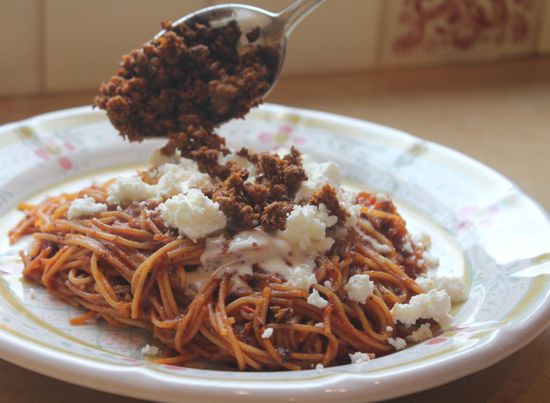
We’re almost half way through the Year of Meat. We’ve salted, cured, brined, and smoked. Now, it’s time to make sausage. Grinding meat from whole cuts, blending in the perfect ratio of clean fats, and flavoring just to your taste with spices, herbs and more – it’s nothing short of amazing.

To prepare for this challenge, I sought out expert advice. You Charcutepalooza-er’s have a lot of fans out there, and some seriously impressive people were delighted to chime in and make sure we’re doing all we can with this great meat-movement.
From the beginning, we’ve been talking about sourcing the best meat possible – humanely raised and humanely slaughtered. What better time to reassert that intention then when we make sausage? Controlling the quality of the ingredients always results in a superior product. There’s a reason for that, especially with meats. Look for pastured, grass fed, happy animals. We are what we eat, and so are they. Antibiotics in my meat? No, thank you. Meat is tastier when the animal is properly raised – and properly slaughtered. Fear hormones released into the muscle fiber will not make for a good final product. Plain fact. This graceful Food Curated video, beautifully constructed by Liza deGuia, (on Twitter, @SkeeterNYC) shows what it means to slaughter humanely.
There are fewer and fewer small scale slaughterhouses – how do we ensure the availability of humanely slaughtered meat? I make it a point to know my farmers. And when I can, I buy farm raised and slaughtered meats, in good part because of one writer’s work.
Barry Estabrook’s brilliant political food writing in Gourmet opened my eyes and my consciousness. I’m still mourning the loss of Gourmet, but keep up with Barry’s insights on his blog, Politics of the Plate. Last January, when Barry published an elegy to Léo, and his life on a rural Vermont farm, I was riveted. When I emailed Barry, he had more to say.
A small-scale meat cutter said to me, as she confronted a huge pile of ground beef on the table in front of her: “They say that corporate meatpackers can’t tell you how many cows go into a pound of ground beef – hundreds, thousands, perhaps. I know how many cows went into this ground beef (gesturing) — one.”
You’ll be buying whole cuts and butchering them down to make sausage. Boneless, or bone in, you will be holding a piece of the animal. It’s a good reminder to honor that animal and the farmer who raised it and sent it to slaughter. And the butcher who cut it into a piece you can manage.

The May Challenge: Grinding
From the first chuck roast I made into a hamburger – ground, formed and grilled by me – I was a changed cook. The possibilities were endless. I didn’t learn to put ground fillings into casings for years. First, I worked on technique – understanding the grind, playing with textures, adjusting spices. And that’s what we’re encouraging you to do this month. We’re asking you to study the art of meat grinding. Try out different grinding techniques and mechanisms. Play with flavorings. Please refer to our handbook, Charcuterie, for more recipes, further explanations and wonderful illustrations.
And then, go to it. Have fun. And let us know all about your creations.
Using any method to chop the meat, for the Apprentice Challenge, we ask that you make Breakfast Sausage patties.
Using any method to chop the meat, for the Charcutiere Challenge, please make either Merguez or Mexican Chorizo (as bulk sausage.)
Post on the 15th. Tag your post charcutepalooza and we’ll be sure to see it. Share your blog post with Punk Domestics. Cross post and upload photos on Charcutepalooza’s Facebook page and Flickr page. And don’t forget to share all those great original recipes on Food52.
More questions? Want to share your smoking experiences? Have questions about grinders? Monday, April 18th starting at 9PM EDT, there will be a Twitter Chat with Michael Ruhlman and Bob delGrosso. We look forward to seeing you there – just check in at the #charcutepalooza hashtag.
A Farm Visit and Oh, What a Farm
I recently spent the day visiting Bob delGrosso, one of the Charcutepalooza Grand Prize Judges, and charcutier and butcher at Hendricks Farms & Dairy, an artisanal shop/farm tucked away in Eastern Pennsylvania’s Mennonite country.

I asked Bob to offer advice to the novice sausage maker. Like much of what we’ve learned this year, sausage-making is an age-old culinary skill. We discussed boeuf haché, classic French cuisine’s minced beef; and the adjective haché. Leave it to the French to have a word specifically describing chopping meat. How about the etimology of the Italian word, mortadella? From the mortar used to grind and emulsify the meats. Yes, clearly, this work can be accomplished by hand. But now there are power-options.

Opening the refrigerator door, Bob showed me the grinding equipment. Solid steel and ice cold, the elements, the feed tube, and the worm (the spinning interior piece) all made of smooth, polished steel. Well-chilled meat passes through the grinder quickly, remaining cold, even after grinding. He had two grinding tips.
The grinder, the worm, the blade, the disks – all must be very cold. The meat should be nearly frozen, so the blade slices cleanly through the meat fibers. Keep everything cold, work quickly and efficiently, and re-chill often. Combine your ingredients well once the meat is ground. Remove the air during this mixing or the end product will be crumbly.
It was a great day – I saw the smoker, talked about butcher shops, met the goats and came home with some amazing food. I promise to write more about my time with Bob soon – it was a fantastic afternoon.
Mise en Space
Stage your kitchen.

You must keep the meat cold before grinding and after – all those exposed cells – warm, ground meat – could breed bad bacteria. Keep everything cold cold cold. If possible, use metal bowls – they hold the chill so well. You’ll want one or two big bowls to use as ice baths.
There should be plenty of room in your freezer for grinder parts and bowls of meat.

You’ll be toasting seeds, grinding spices, making slurries – set out all that equipment, too. Mortar, spice grinder, blender, food processor, knives, cutting boards and all the spices, salt and ground pepper. Have plastic wrap at the ready.
Take out a small skillet. Once the sausage is mixed, small patties are cooked off for a taste test – does it need more salt? flavorings? moisture? Adjust and taste again. Each time you make sausage, your salt and seasoning needs will change with the taste of the meat you acquire. So, the test patty is part of the process and the cook is the beneficiary.

Use clean hands, or your stand mixer, to combine the ground meat and seasonings really well. As Bob said, get the air out. Dominique, the Chapolard butcher, gathers the sausage mixture in his hands and slaps it down on the work surface, forcing the air from the mixture. Whatever your method, mix it up really well. If the mixture seems dry and isn’t holding together, add some liquid, often shown at the end of the recipe as an optional ingredient.
Grinding Meat Using the Food Processor: Breakfast Sausage
Your food processor is an excellent meat grinder. Surprised? Check out this technique primer from Bon Appetit (via Food52.)
For the food processor, the meat and fat are cut into 1” cubes. Toss the meat with the spices and cover and chill. I like to let the meat and spices get to know each other for at least two hours, the last 30 minutes spent in the freezer.
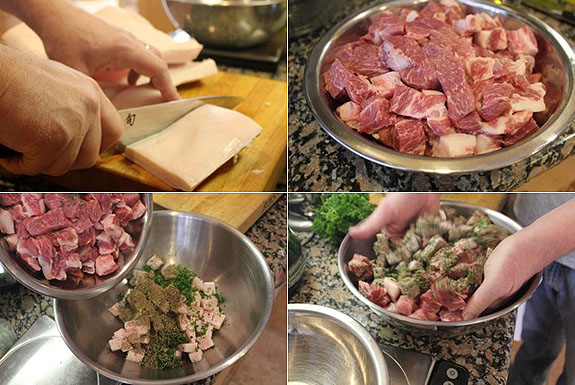
For this challenge, the excellent pork shoulder came from Smith Meadows (Dupont Circle, Takoma Park and Broad Branch farmers markets in the DC area.) The pork back fat was from D’Artagnan, and I must say, it was the cleanest, prettiest fat I’ve ever seen.
We pulsed the meat and fat in four small (3/4#) batches, checking after 15, 30 and 45 pulses. The texture was perfect after 45 pulses – light and well blended. Once the meat is ground, remove it from the processor to a separate bowl, and keep it cold in the ice bath or the refrigerator. When all the batches are done, work the sausage meats with your hands, removing air and combining all the ingredients. Add cream if needed, to hold it all together.

Fry up a test patty and adjust the spices as necessary. Cream may be needed to help the patty stay together when cooked. Be stingy, add small amounts, and test, test, test.
When it’s perfect, go ahead, fry up some patties, add some maple syrup, and have breakfast, or pack it up for storage.

There are two options for storage. Either form patties, freeze them solid on a baking sheet, then package, alternating with parchment paper squares and freeze. Or weigh out one pound of the mixture, then gently form the sausage into a roll, removing any air pockets, and roll it up in plastic wrap. Store in a ziptop bag. Fresh sausage will keep for a week in the fridge, or in the freezer for three months.
[print_this]
My Breakfast Sausage
3 lbs boneless pork shoulder
3/4 lb. back fat
.3 oz dry, rubbed sage
.1 oz Herbes de Provence
1/4 c finely minced fresh parley
5 t fresh thyme leaves, laboriously and annoyingly picked off the stem
2 -3 tsp kosher salt – to taste
1-2 tsp freshly ground black pepper, to taste
1 T heavy cream, optional
Cut the meat into 2″ cubes (1″ if using the food processor) and the fat into 1″ (1/2″ for the food processor) cubes.
Add the spices and mix well. Chill for two hours, the last 1/2 hour in the freezer.
Run the mixture through the grinder.
Mix the sausage meat well, using your hands or the stand mixer paddle attachment to combine and reduce the air in the mixture.
Form patties. Over medium heat, fry the sausage patties in a skillet until crispy on the outside and cooked through.
The sausage will keep one week in the refrigerator or three months in the freezer.
[/print_this]
KitchenAid Stand Mixer Grinder Attachment: Mexican Chorizo
The KA attachment has been my grinding companion for the last two years. It’s easy to use, easy to clean, and relatively inexpensive. And it’s great for all kinds of things – Hash up some Leftovers! Make Breadcrumbs! Purees! Baby food! You’ll go wild.

To set up your workspace, elevate the mixer above the counter by about 3”. I use a book or stacked cutting boards. Place a large ice bath in front of the mixer and float the KA mixing bowl in the ice bath. Attach the grinder and adjust so the ground meat will fall into the mixing bowl (not the ice bath!)
Push the chilled meat through the chilled feed tube toward the chilled worm. Feed the meat through, with the speed no greater than #4. Use the plunger or a wooden dowel cut to fit the diameter of the feed tube. If it’s good and cold, the meat will slip through without forcing.

When all the meat has been fed in, twist a piece of plastic wrap into a 12″-14” rope, and insert into the feed tube. In two seconds, that magic bit of plastic will push the remaining meat toward the grinding disk, so little is wasted. Turn off the machine as soon as you see the plastic appear behind the grinding disk, remove the entire grinding mechanism and clean it, while the meat chills (again.)
Pati Jinich Talks Chorizo
Pati Jinich, the exquisite Mexican chef, answered my email enthusiastically when I admitted a love of Mexican food, but little experience cooking chorizo. She invited me to her sunny kitchen for a Mexican cooking lesson.
If you don’t know Pati, it’s time you did. She’s starring in the new PBS cooking show, Pati’s Mexican Table, where she guides the viewer through lively, colorful, meals with interludes of music and history – it’s a delightful, traditional, expressive, creative romp through Mexican home-cooking. Pati’s blog is full of approachable recipes and evocative tales.

Pati transformed chorizo and a few simple ingredients into Pasta Seca – a classic of the Mexican kitchen, with many regional and home-cook versions. It was so delicious and tasty, you can be sure it will be on my home rotation from now on. (Anthony Bourdain would call it out for what it is – great hangover food. Seriously.) Pati’s recipe is perfect. Imagine toasted pasta that plumps up not from boiling in water, but from the tomato/chile/onion sauce it’s simmering in. Then top it with chorizo – spicy, crispy pork. Crema. Cojita. Avocado. Are you in?
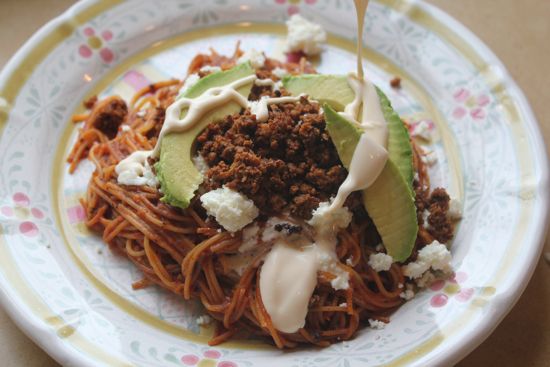
Check out Pati’s chorizo post for inspiration. The key ingredient? Vinegar. That’s what makes the meat crumbly. In Mexico, the common vinegars are apple cider, plain white, and, recently, rice wine vinegar. There are chorizo versions from every corner of Mexico, including a green chorizo from Toluca (the chorizo capital.) I encourage you to read all about it, then strike out and make a version that speaks to you. Pati’s cooking tips for chorizo –
When you cook chorizo, break it up and really crisp it. Let it get well browned. It makes a big difference in how the flavor is infused into the dish. Some Mexican recipes will remove the chorizo from the pan, adding it back at the end, to retain the crunch. Others add the rest of the ingredients to the chorizo, so it becomes a flavoring, used in much the same way as lardons or pancetta.
[print_this]
My Mexican Chorizo
3 lbs boneless pork shoulder or butt
1 large white onion
5 Ancho chiles, dried
3 Chipotle chiles, dried
1 Guajillo chile, dried
1 c boiling water
1 T annatto seeds, crushed
2 T paprika
1 tsp Mexican oregano, crumbled
1 tsp freshly ground black pepper
1/2 tsp Mexican cinnamon
Pinch each ginger, clove, cumin
2-3 t salt (to taste)
1/3 c apple cider vinegar
Cut the pork into 2” cubes and put the meat in the freezer to chill for at least 30 or as many as 45 minutes.
Toast the chiles quickly in a dry skillet just until they are flexible and fragrant. Remove the stem and seeds. If you want spicy chorizo, Pati says, “Save the seeds, toast them lightly and add back in to increase the spicy flavor.” Careful, now. They’re hot. I add these after taste testing.
Tear the chiles into a few pieces and rehydrate them in a cup of boiling water. Let them soak for about 15 minutes. Drain and reserve the soaking liquid.
Make a slurry in the blender. Add the chopped onion, the chiles, the spices and vinegar to the blender. Add the chile soaking liquid to loosen the slurry until it’s just pourable. Chill the slurry while you grind the meat.
Set up the grinder and grind the chilled meat into a chilled bowl perched in an ice bath. Combine the meat with the slurry.
Using your hands or a stand mixer, combine everything well at a low (#4) speed. If you mix with your hands, wear gloves. Use the chile soaking liquid to moisten the sausage, as needed.
Add some chorizo to the tasting skillet and cook until well browned, breaking it up to a crumble. Taste for salt, pepper, and spicy heat and adjust to your liking.
Mix again well, Get rid of the extra air. Pack the chorizo in half and one pound packages. If possible, let the chorizo rest for a day or two before cooking with it. This sausage benefits from a little rest.
Chorizo will keep in the refrigerator for a week, and in the freezer for up to three months.
[/print_this]
The Waring Meat Grinder: Merguez – Lamb and Venison
Paul has a Waring grinder and I have to say, I’m getting spoiled. It’s really nice. All metal worm and grinder means the cold is retained, the meat is processed very quickly, and the quality of the grind is gorgeous. There are three grinding disks – very coarse, medium and fine. I particularly appreciate the all metal construction when using spicy, wet mixtures like the Chorizo or Merguez.
We made Merguez, using my food52 Wildcard recipe. (Here’s Merrill’s new merguez hash recipe, too. I can’t wait to make it.)
Lamb shoulder is not an easy cut to find – most of it never comes to market (it’s made into sausage.) Be prepared to order ahead. The shoulder has the perfect ratio of fat to meat, and great flavor. We used a beautiful 5# bone-in Australian lamb shoulder from D’Artagnan and everyone agreed it was exquisite. The flavor was earthy and fresh, not gamey, but rich. It was, hands down, the best lamb I’ve ever used to make this sausage.
As with Chorizo, there are many regional versions of Merguez. Stir up your own spice mixtures, make sure you toast the spices, play with all the flavors. Make a mixture that smells like the souk or like you think the souk should smell. Find a great harissa, or make your own. (I love this one from TasteFood.)
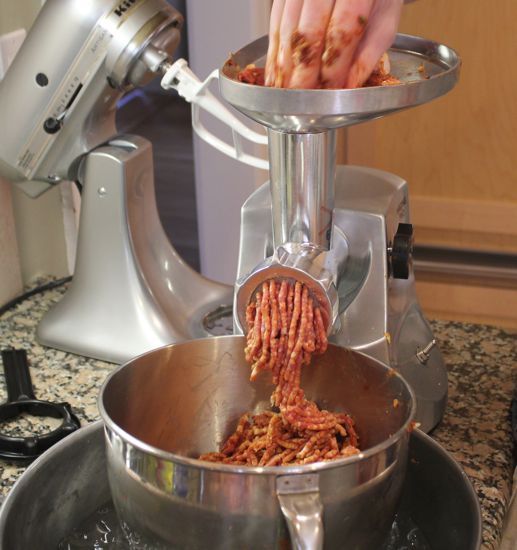
We also made a merguez with venison. It needs more work, recipe-wise, but exhibits great potential. If you have access to game meats, give it a try.
As usual, to complete this challenge post, thanks go out to Paul and Elaine, who joined me for a day of Charcutepalooza. Paul did some amazing butchery work (channeling Dominique Chapolard), deboning the lamb and the venison. Elaine took a lot of the photos, and I wielded a knife, ground spices and made slurries. Six hours and 30 pounds of meat later, several friends joined us for vegetarian cassoulet, grilled Merguez, new season kale, Cowgirl Creamery cheeses, and a few treats from the larder. Oh, and wine. Plenty of wine.
Have a great time making sausage. We can’t wait to see what you come up with. Remember what the experts shared – source the very best meat from farms where the animals are treated well. Keep everything cold and mix it up well. And when developing flavors from other cuisines, research regional differences and be creative.
A Little Charcutepalooza Business
Kim, Sean Timberlake from Punk Domestics and I will be presenting a hot-smoking demonstration at BlogHer Food in Atlanta (May 20-21.) If you are in Atlanta, we need help shopping and locating supplies for our demonstration. Please get in touch if you’re willing and able. Thank you!
And, when you have a moment – please click on this fantastic Google map to add your location. We hear Charcutepalooza is happening everywhere – please show us where! Thanks go out to Scott for getting this cool map organized.
Charcutepalooza loves our sponsors. Kinetic Web Solutions and @VinoLuci saved me from having a meltdown over Photoshop this week and generally helps us navigate technology. D’Artagnan , generously offering 25% off the meat-of-the-month. If you aren’t receiving your email with the secret code for Charcutepalooza members, register here. And the trip to France – an awesome grand prize deliciously designed by Trufflepig and Kate Hill at Camont.











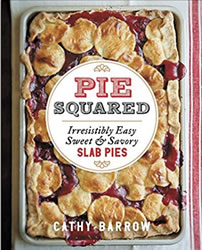

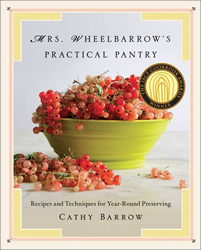
Winnie
Cathy I think you’ve outdone yourself once again, which hardly seems possible since each month I think the same. I only had time to scan for now, and will come back and read every word soon, but as usual, you are so ridiculously thorough and I love all the photos!
Mardi@eatlivetravelwrite
I am SOOO excited about this challenge and thank you for making it casing-free. I like the fact that we can work on technique before we start worrying about that…. Love merguez and love breakfast patties. Glad I got my English muffins down for the last challenge!
Sandra Kay Miller
Time for a batch of goat Merguez!
Janis
Jumping up and down…jumping up and down. I just happen to have a pig, a lamb, and venision in my freezer. All came from people I call friends and care about. I am so excited.
You outdid yourself on this. I want to be like you when I grow up.
Robin@GoodforthePalate
This takes me right back to L’Academie de Cuisine. Glad I bought that grinder attachment now.
I have some exciting plans in the works.
Charcutepalooza is great because acquiring the ingredients and planning the recipes is as much fun as getting your hands dirty in the kitchen!
Mrs. Larkin
Brilliant, Mrs. W! I think this is one of my favorite C-palooza installments so far. Makes me ALMOST want to throw my scones to the wind and make meat!
Christina McPants
I bought myself the KitchenAid meat grinder off my registry last night. HELL YES, IT’S SAUSAGE TIME.
FrenchtwistDC
I haven’t eaten meat since the beginning of lent so this post is torture. Awesome torture. But torture nonetheless. Good luck with all the grinding! What a fun project!
Lynn
Cathy,
I am so excited for sausage. I am a complete novice at this, and appreciate your detailed instructiosn and photos. I bought the Kitchen Aid grinding attachment last month, knowing sausage must be in our future!
Merguez!
Brad Weiss
Anybody recommend a good, less pricy, home sausage stuffer?? I want to give andouille a shot. I’ll be using my cuisinart for grinding- no KitchenAid in my kitchen.
Christine
I am so very excited for sausage! I love it but have never made it because I feared the whole casings thing. Duh, bulk sausage, of course. Thanks for making this so accessible!
Cecilia
What a great detailed post, and the photo of your pasta seca is gorgeous! I can’t wait to get started on this challenge. I’m so glad we don’t have to deal with casings right away :O)
Domenica
Cathy, your monthly Charcutepalooza challenge posts are truly something special. The amount of thought and effort that goes into each one is evident. Thanks so much for your hard work. Now…when are we going to get together to make Soujouk??
Cathy
Anytime! Those spices were calling to me when I made the merguez. I’m thinking they would be amazing with goat. Painted Hand Farm at Bethesda Central Farm Market has goat, too. 🙂
Richard
I’ve been making sausage for a while (since I was 8 years old), but didn’t get in on Charcutepalooza due mainly to time and work constraints. However, I’ve greatly enjoyed reading all the posts about it. One small quibble, and it’s a safety issue: “The plunger is alright, but using your hands is a little more delicate.” KEEP YOUR FINGERS OUT OF THE FEED TUBE ON A GRINDER!!! THERE ARE NO EXCEPTIONS!!! I don’t like the plunger that came with my Kitchenaid grinder either, but putting your fingers down that feed tube is an excellent way to lose part of a finger. It’s a very bad, and dangerous habit to pick up, and I’ve seen what a commercial meat grinder can do to a hand. It’s not pretty. Instead of the plunger, I use a larger diameter wooden dowel that fits the tube perfectly, and I still have all my fingers.
Cathy
Richard, you make a very good point. I will change the post right now. My experience is that well chilled, nearly frozen meat will slip through the feed tube without needing to be forced. Forcing warm meat with the plunger destroys the fiber.
Carma
I’ve been making our breakfast sausage for some time now and am looking forward to “upping my game” a bit with the cased sausages. Wanted to point out this is a good time to explore sources for quality bulk spices (I’m a die hard Penzy’s customer). The grocery store bottles are many, many times more expensive (often 10 time or more!) than purchasing directly from a spice dealer.
Richard
Find an Indian grocer in your neighborhood. They will have bulk whole spices at a fraction of the cost.
Oui, Chef
Very excited about this month’s challenge, Mrs. W. I’m going to work on reproducing a merquez-frites sandwich I used to buy from a small shop around the corner from LCB in Paris, it was SO GOOD! Thanks for your detailed descriptions and photos above, they are a great and generous start to my research. Cheers – S
bob del Grosso
Jeeze Cathy,
Did you set out to make every other food blogger look like an underachiever? I’m crawling back into my hole. Damnit. 🙂
gluttonforlife
Cathy, you mad genius–when do you sleep?! Thank you for this wealth of information, your enthusiasm and the meaty inspiration! xo
Tonya - What's On My Plate
YAY! I used my grinder for the first time a few weeks ago for hamburgers and now i’m hooked. Looking forward to this one.
Michele Garcia
What a great source of information for grinding your own meat and sanitary procedures. After reading the recent articles in the news about antibiotics in meat, your Charcutepalooza blog is quite timely for people like me in search of safer, healthy alternatives. I can’t help but be convinced that the growing food revolution becomes more important every day.
Josh
3 oz of sage by weight?? Are you sure? Based on how much I had, 3oz by weight would be about 4 cups or so, by volume.
Cathy
Thank you for calling this out. It should say .3 oz. – about 1/4 cup. I’ll change it on the post. Thanks.
Josh
and the herbes de Provence? Don’t think you want a full cup (1 oz) of those either….
BrianS
Excellent! I purchased the grinder attachment for my KA mixer and have not had a chanve to break it out. With grilling season finally arriving (sort of, spring has sucked in the PNW) it’s time to experiment with grinds, meats and spices.
B
Maygun
Looks great! I couldn’t wait until May to start grinding and casing, so this month, in addition to Tasso, I also made Andouille. They are both amazing, and I’m making gumbo tomorrow. The Merguez recipe in Ruhlman’s book is really good, but since I’ve made it before, I think I’m going the Chorizo route this next month. This has been so much fun so far to participate and see what other folks are doing each month.
In looking at the blog sites it looks like a lot of people dropped off the challenges after the first couple months. Cathy, any idea how many people are still charcutepalooza-ing?
Cathy
Great to hear about the recipes and your successes! Thanks for asking about the charcutepalooza membership. As there is no obligation to participate every month, and we expected some folks might not do the smoking challenge, we’re thinking we still have nearly 400 blogger and non-blogger Charcutepalooza-ers – some of whom sat out last month’s challenge.
Ian
Having just found your site, I shall be joining in as soon as I can. I have recently started to learn Charcuterie and have attended a course with a local producer on curing bacon and hams, as a side note on the course we touched on sausages and i have some great recipes I want to try out.
Great site and a fantastic concept prime pork is there anything better I think not.
Ian
Abbe
I think I may finally be inspired to make breakfast sausage in cute little casings this month! But it’s too early for good fresh sage here. Bah.
Cathy
I use dried sage in my breakfast sausage. The fresh is too strong.
Naomi
I know I’m getting around to reading this post a little late, but I just had to comment on your brilliant KA grinder plastic wrap trick! I’ve owned the grinder attachment for years and am always sad about the wasted meat left inside after using. Thank you so much for your elegant solution to the problem! I can’t wait to try it out.
Cathy
I give total credit to Chef Bonnie Moore at L’Academie de Cuisine for teaching me that little trick. Have fun with the sausage-making!
Abbe
In our house with use the trick of feeding a piece of bread through at the end – you get a mix of meat and bread that you can fry up into a little patty and eat.
Heather
I ground pork loin chops with their caps and seasoned with chile flake, oregano, garlic and fennel seed and made some delicious Italian sausage. I’m not sure if I needed to go a little finer on the grind, though, because it took on more of a ground pork consistency when it was cooking. I think next time I might try tossing it into the food processor for a tighter grind? Didn’t really matter, though – local, hazelnut-finished pork tastes amazing (I used it in some pizza pockets).
Cathy
Sounds delicious! I would guess the consistency when you cooked it may have had more to do with inadequately removing the air from the mixture, not the grind. Make sure you mix it well with the paddle of the mixer or your hands.
Carolyn
I can’t believe we’re almost halfway through the year! I made the breakfast sausage, and I think it’s changed my mind about what breakfast sausage can be in the right hands. And, it gave me an excuse to bite the bullet & purchase the Kitchenaid mixer I’ve always wanted 🙂
Here’s my post for this month:
http://cpluscdesign.com/gastography/2011/05/15/fresh-breakfast-sausage-charcutepalooza-challenge-5/
Claudia
My post is up, and thanks to you folks I have been doing stuff I never would have without this challenge. Learned that I don’t have to grind so fine, and need to knead more air out.
Mr Belm
I stuffed the chorizo and cold-smoked it:
http://blog.belm.com/2011/05/15/charcutepalooza-chalenge-5-cold-smoked-chorizo/
Abbe
My post is up too – just some basic poultry breakfast sausage. Really I learned more about stuffing and about butchering turkey legs than about grinding.
http://outoftheboxfood.blogspot.com/2011/05/sausages-for-breakfast.html
Robin@GoodforthePalate
Check out the GFP May 2011 post “You Never Sausage a Place”
I also skipped to stuffing, But next month will be homemade buttermilk biscuits, with breakfast sausage and fried egg. And maybe some cabot clothbound cheddar.
http://www.goodforthepalate.com/2011/05/you-never-sausage-place.html
Livia
Well, I finally got the May challenge written up. 🙂 Thank you very much for the detailed instructions – they were wonderfully clear and easy to follow, and I’ll be making ground meats again.